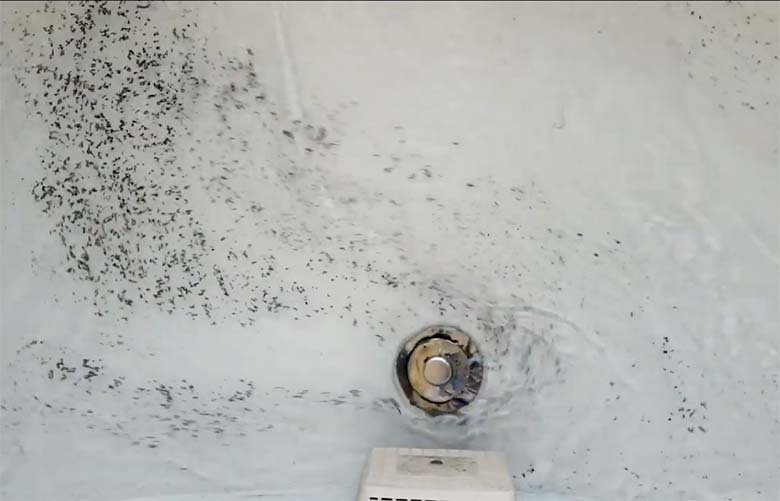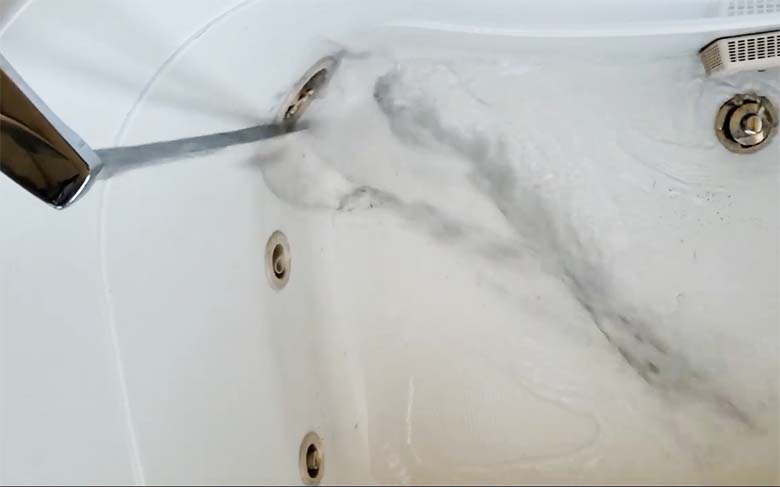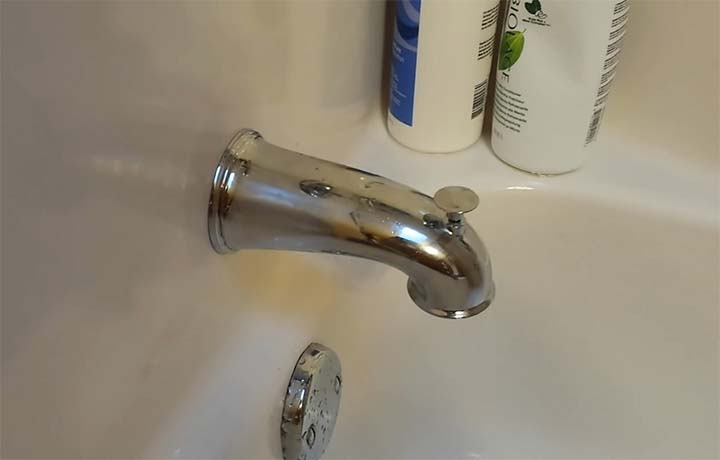The bathtub water is expected to be crystal clear without any contamination. In fact, every water faucet and valve must serve you with the cleanest water possible. So, seeing black specks in bathtub water can be scary and worrisome.
At one point, it is visually a gross experience. On the other hand, black specks in the tub water suggest something wrong with the water supply line. Maybe the pipe has rusted too much, or the rubber in the gasket and pipe has started disintegrating and eroding the water heater. At times, the water reservoir may have developed too many residues and metallic elements, causing the black specks.
Hence, you must inspect the reason of bathtub having black specks and ways to remove them. It will help you enjoy a sumptuous bath with greater relaxation. The black specks aren’t good for your health too. So, you must immediately remove them.
Why Are There Black Flecks In My Bath Water?
You go to your bathtub, turn on the water faucet, and are about to walk into the tub. Suddenly, you notice the water is not clean. It contains black specks and looks ugly. Understandably, it will be a horrible experience. Also, the tub with black flecks suggests there’s something wrong with the water supply lines. So, you must inspect the reasons quickly.
If you delay finding the source of black specks in the bathtub and don’t fix it timely, the scenario may deteriorate further. Moreover, the bathtub will remain unusable as long as black flecks are in the water.
Corroded pipes of the water supply line:
The main water line in residential and commercial spaces are made of metal. Mostly, older homes have cast iron or galvanized steel pipes to supply water. Over the period, these galvanized steels and cast iron materials would wear out. Usually, these pipes at home have 10 to 15 years of lifespan. Once these water supply lines pass their lifespan, they start deteriorating.
Moreover, there will be rust and corrosion build up inside the pipe. So, these steel and iron materials will start breaking apart into tinier pieces. It intensifies the corrosion.
The black flecks you see in the bathtub are nothing except the corrosion flecks. As the pipes grow older and erode, the water will get contaminated with more corroding flecks. It is common everywhere you see cast iron and galvanized steel.
The black flecks in water are, therefore, more concerning. It suggests that the water supply lines are damaged. So, you must also look for leaks and further damage. Otherwise, it can cause you with costlier repair and replacement.
Carbon-activated water filters:
Many homes use a water filter to screen the water from the main supply lines. If these filters use carbon-activated filtering, they might release black specks in the water during the filtering process. The cartridge of the carbon water filtration will release black particles.
If the black particles are too many, they will form a thicker surface in the water. As a result, you will see more black specks in the bathtub water. When it happens, there’s nothing to do with the central plumbing system of your home.
Some cartridges will release more carbon-activated particles than others ones. So, it triggers the black specks production to make the water look contaminated. If this is the case, you don’t need to worry about the water condition at all.
Mineral build-up:
Minerals such as manganese and irons can gradually develop inside the main water tank and supply lines at home. This mineral deposit problem can be more acute than anticipated if you live in hard water regions.
Hardwater often carries manganese, iron, calcium, etc., minerals. Slowly, they will develop inside the water tank of your home. As the deposit increases, it will start going into the water supply lines. So, it will come through the water faucets, showers, and tubs.
The scene will be startling, although the tiny mineral in the water isn’t harmful. If the black flecks are too many, it can be a concerning problem.
Sand and silt from wells:
Many older homes may still have well in their lawn and garden. The groundwater in the well will receive the minerals, silts, and sand from the soil. As a result, water in the private well gets contaminated. If you connect the bathtub water supply lines with the groundwater of your well, it can cause black flecks too.
Sand and silt in water aren’t harmful. However, it looks gross and shouldn’t be tolerated to improve the water supply lines. So, you must check the well and try fixing the issue.
Disintegrated rubber parts:
The entire plumbing system has multiple rubber parts in it. It includes a rubber washer, gasket, thread pipes, etc. With time, these rubbers of the different parts of the plumbing system will wear out and start disintegrating.
The decaying rubber gasket and washers will slowly release the rubbery particles in the water. The easiest way to identify these rubber disintegrations is to check the smell of the water. If the rubber of the washer and gasket is causing the black flecks, you will get a rubbery smell from the water. Usually, the specks at a minor level suggest that the gasket around the bathtub faucet is damaged.
Nonetheless, the powerful presence of black specks in bathtub water might indicate more serious problems. So, you must be careful in dealing with rubber disintegration.
Corrosion in the water heater:
Lastly, corrosion inside the water can also be responsible for black specks coming out of the bathtub faucet. Yes, it is possible, although it might seem highly unlikely. If you turn on the hot water faucet and see black flecks in the water, that’s undoubtedly because of the water heater.
Possibly, the metal inside the water heater is damaged. Also, the rubber gaskets and seals inside the water heater may be broken and disintegrated. So, the black particles will carry through the hot water supply lines. You won’t see the nuisance when you turn on the cold water faucet.
How to Get Rid Of Black Specks in Water

We have mentioned the top six reasons for black specks coming out of bathtub faucets. So, it’s time to see the ways to fix the problem. Depending on the source, you must take different measures to remove black particles.
Changing the filtration cartridge:
If the carbon-activated water filter is the root of the problem, change the cartridge. It would help if you used cartridges that don’t release carbon too much in the water. So, changing the cartridge would solve the problem promptly.
Replacing the older gaskets and washers:
You should look closely at the rubber gasket and washers of the tub faucet. If these are worn out or damaged, you should replace them. It is an easy task that has the following steps:
- Turn off your main water supply carefully and allow the lines to dry completely
- Use a flathead screwdriver to pry off the faucet cover and access the inside cartridge.
- As you remove the cartridge, you should access the older gasket.
- Now, replace it with a new one and remount the bathtub faucet properly.
- If there’s residue and mineral development inside the cartridge, clean it too.
Stop supplying water from the ground well:
Sometimes, contamination in the well water can cause black specks in water supply lines. So, it will lead to the tub. You should stop supplying water if you have an older well at home. It is also well because supplying water to the main tank from the ground well is time-consuming. It will also save your electricity bills.
Repair the older pipes:
Older pipes made of cast iron and galvanized steel might also cause black flecks in water. In fact, this is the main reason for black specks in water supply lines. Thus, you need to call a professional and do a video inspection of the plumbing system.
Through the video inspection, the plumber can identify where the corrosion has occurred. Also, it helps you assess the damage level. Then, you can proceed to fix, repair, and replace your home’s corroded plumbing. As you eliminate the corrosion from the water supply lines, it should also remove the black specks from the bathtub water.
Note that this is a critical inspection, and fixing the corroded pipes is more important. Or else the corrosion may lead to leaks in the supply lines and cause more problems in the future.
Cleaning the main supply tank:
If you last cleaned the water reservoir in your home a while ago, it’s time you clean it. You should use cleaning agents such as bleaching powder and vinegar to clean the entire tank reservoir closely. Often, an uncleaned tank causes water contamination and imports black specks into faucets.
Removing the sediment and residual build-ups from the tank will provide you with cleaner water. It is also helpful to maintain hygiene in the home.
Cleaning the water heater:
You should also try removing the corrosion inside the water heater. Carefully observe which part of it is eroding. If it is replaceable, replace it. The rubber and iron wiring used to heat water often erode over the years. Thus, you should find a way to stop the corrosion. Alternatively, call an expert plumber and let him look after the matter.
Black specks in bathtub water always suggest a dysfunctional plumbing system. Hence, the key is maintaining the home plumbing system properly and keeping it corrosion-free. It will save you from the problem of black specks in the bathtub, and enjoy a perfect bath.
I am James Martin, An professional plumber with more than 16 years of experience. The main purpose of my writing is to share my experiences of helping others. Be with me and explore bathroom plumbing, installation, cleanness ideas, and many more.




